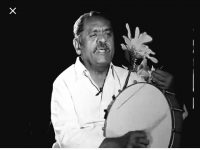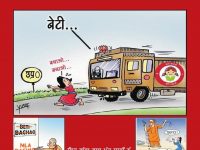Pravin Nadkar
The politics in Maharashtra has sprung up an unexpected surprise before the ruling BJP led government in the state. The importance of the caste factor in the state politics has once again come to the fore. The recent initiative of political assertion of the Maratha identity is under the banner of ‘Maratha Kranti’. Considering that kranti i.e. revolution is a term used to describe the struggle of the downtrodden against the establishment, it can not be denied that this movement too enfolds trends against exploitative policies of the establishment. In fact a frustration arising out of inability to improve the living conditions of their own lot, is at the centre of the social turmoil in the offing.
The irony of the situation is that, traditionally, the ruling elite in the state also comes from their own community. This section of Marathas has been enjoying power in each and every field of state governance and rural economy. They are being, somewhat, side lined by the present ruling BJP led government . BJP is making alliance with the new elite players from the OBC sections and trying to woo the dalits in the state. In such a situation, the elite Maratha is trying to find its way back into the corridors of power. They are taking advantage of the disenchantment of the vast sections of the impoverished Marathas with the existing system. This outburst of Maratha identity has provided a timely opportunity to the elite Maratha sections across the political parties. These parties wish to exploit the situation in their own favour for the impending elections at Panchayat and district levels in the state. As such sections of impoverished Marathas i.e. agricultural labourers, saldars, small peasants, urban working population etc. are in a situation where they are joining forces with the very elites who are primarily responsible for their present plight, in the name of the caste. The revolutionary potential of this movement is thus compromised at the very outset.
The famous onion price agitation led by Sharad joshi, had witnessed a similar situation way back in eighties. Where as the landlord forces and other rich peasants benefitted by the consequent rise in the market prices due to the agitation, the poor peasants and the agricultural laborers who lost their lives in that movement were only used as cannon fodder. They did not in any way benefit on account of the trickle down effect as then claimed by Sharad Joshi. However Sharad Joshi had correctly assessed the beginning of downslide of the agricultural sector in the Indian economy and his intervention provided a timely vent to the feeling of rebellion building up among the peasantry. This agitation succeeded in imparting a reformist orientation to the nationwide peasant movement, there by blunting the revolutionary edge of the movement. Maratha landlords and rich peasants were in the leadership positions of this movement too. As a second wave of agricultural distress is spreading across the state, the ruling classes should be too happy and working hard to subvert this agitation in a casteist direction.
Marathas in Maharashtra have been generally equated with the Jats in Haryana. Caste wise, there has always been a confusion about whether the Kunbi, the predominant peasant community is a part of Maratha caste or not. Kunbis are the non-elite sections of Maratha tillers. They consist of various sub castes like Leva patedars. Khaire, Jadav etc. regionally in the state. There is an opinion among certain sections of sociologists that Kunbi is a reality and Maratha is a Myth. This opinion is based on the consideration that majority of those who call themselves Marathas belong originally to the Kunbi caste. The elite castes among Marathas the 96 kuli (96 clans) Marathas and the Maratha Deshmukhs (traditional village level chieftains) are said to be the real Marathas. The Kunbi sections always take pride in being called as Marathas. Since the onset of Mandal Commission a section of the Kunbis have started to demarcate themselves from Maratha in order to claim the benefits from the OBC reservation. Leva Patils, and some other Kunbi subcastes are already included among OBCs list and are eligible for reservation. As such there is also a section of Kunbis which is hesitant to join forces with the Maratha agitation for the fear of losing percentage their own share to the new entrants in the race for reservation. Marathas are said to belong to the Kshatriya varna where as Kunbis belong to the either Vaishya varna as per their occupation of agricultural production and Kunbis are even described as Shudras as they directly engage in physical labour themselves. In fact, the famous icon of Marathas, the king ‘Shivaji Maharaj’ was himself denied a felicitation for the throne by Bramhins as they held him to belong to the Kunbi caste and hence a non-Kshatriya.
Land owning Marathas among the peasant sections, those belonging to small and middle peasants, have suffered a major economic crisis on account of the drought like situation in the last couple of years. This prompted them to commit suicides in a big way. The numbers from the Maratha community are highest among the suicide cases in the state. Exploitative pricing policies of the agricultural produce, policy of relying on imports rather than encouraging the market for the local produce, lack of irrigation facilities, power cuts, high costs of inputs etc. is making agriculture non viable as a livelihood option. In these conditions, the Maratha youth sees no future in agriculture and is seeking employment opportunities in the cities. In such a situation the elite Marathas do not encourage the youth to fight for the betterment of agriculture. When the Maratha youth seeks seats in institutes of education or employment in the Government jobs, they feel discriminated on account of the present reservation policy. On the other hand, high fees in private professional institutions are placing a lot of burden on these peasant families and lack of jobs after such training further places economic burden on them.
Even if Marathas are given reservation as per their demand, it can hardly improve their employment situation. The Employment figure for the government related jobs has shrunk to slightly less than half the number in the last few years. As such the reservation becomes irrelevant for better prospects. Educational institutions are also privatized in a big way and as such reservation in admissions too does not better their chance for higher education. It has been a widely held social belief among the peasantry that, in the order of hierarchy, agriculture ranks first as a livelihood option, next at the medium level is trade and lowest ranking is employment. These sentiments are conveniently sidelined by the initiators of the current agitation for reservation. The youth is not encouraged to fight for saving the agriculture from its plight today. Instead urban life and employment for livelihood is projected as the alternative to survive the agricultural distress.
Maratha community has a sizable share of 32% in the population of Maharashtra. It has been traditionally powerful in economy as well as politics of Maharashtra. In both these fields they have become comparatively weaker in the recent times. The Marathas have an unparalleled social clout at the village level. They are in forefront of practicing caste discrimination towards dalits. With growing urbanization, their cultural supremacy and social clout in general is decreasing. Dalits as well as OBCs are able benefit from educational facilities as well as employment opportunities to some extent. Maratha elites dominate the upper echelons of the bureaucracy. They are now unable to accept the backward castes as equal partners in power. This is why the elites utilize the caste prejudices to drive the Maratha youth in the current agitation. In a situation where the job market is not growing and the Government is putting a halt to new recruitment, then extra reservation for Marathas cannot be the solution to their problem. But this is where the politics is at work, behind this so called non-party or all party Maratha agitation.
The impact of globalization started showing in India in a big way since nineties. Rapid urbanization at the cost of preservation of agricultural profession became a distinct trend across the country side. Marathas were not ready for this change. Though a small section of elite Marathas in the state are next to the Bramhins, in the field of education, majority of them did not give much importance to education. The agriculture oriented education is generally neglected in the state and the traditional ways of cultivation did not demand higher education for agricultural occupation among the Maratha youth. This youth finds himself in a peculiar situation today. Majority of this youth comes from Middle peasant to agricultural laborer background and as such finds it difficult when it comes to finding admissions for the higher education or even for employment. On the other hand the status of the OBC section seems to be better than before. As such the social turmoil taking shape among the Marathas also has to be understood in the frame work of the process of globalization.
The other important development around the same period was that the government allowed reservations for SCs ,STs and OBCs at the gram panchayat level way back in 1994. This gave an opportunity for these castes to get elected at the gram panchayat level and also to become Sarpanch of the village. It is a marked departure from the traditional power structure at the village level. It meant that lower caste people could hold politically more important position than the Marathas when the Sarpanch belongs to the lower castes. These changes in the power structure right from the village level and the declining social status of Marathas at the state level has nurtured a deep sense of social resentment over a long period of time. The Kopardi event gave a vent to these frustrations among the Marathas.
It all started with the condemnable rape of a Maratha school girl by some alleged dalit goondas in a Taluk called Kopardi in Maharashtra. The success of the Marathi film “Sairat” had hurt the sentiments of the sectarian sections of Marathas. In this film Marathas are shown to be wielding power in a criminal manner against an inter-caste marriage of a Maratha girl with a dalit boy. Maratha family of the girl side is shown in a negative light and the Maratha leader from the family is shown as a villain in the film. The incidence of rape of the Maratha girl by certain dalits has thus provided an opportunity for the Maratha elite to hit back at dalits and claim a moral high ground.
An ex-employee of a multinational company and an electrical engineer by name Sanjay Patil took initiative to register the names of the accused in the police station on the very next day of the incidence. Day after that he gave a call for Kopardi Bandh. He is one of the important leaders of the movement. A certain Bhaiyyu Maharaj generally in close relations with the Maratha elites was another person who visited Kopardi after the incident. As the image of any existing political Maratha stalwart is not very credible, such non party faces are more acceptable to the Maratha community at large. Seeing the response to the initiative taken at Kopardi a Bandh call was given in Aurangabad city of Maharashtra. The response to this second call was tremendous. It was a kind of spontaneous response. After that various cities took initiatives for such rallies. There is no doubt that Kopardi was only a trigger point and the rape of the a Maratha girl became an incidence of challenge to the Maratha pride and a demand was made to amend the SCs & STs (Prevention of Atrocities) Act. The issue of unemployment was subsequently added to the agenda to attract the unemployed youth from the community. The reservation was then projected as a solution for this malady of unemployment. Seeing the rising spontaneous response and mobilization of Marathas on these demands, Maratha leaders, across the party lines, have jumped into the fray.
The non-political puritanism craftily exhibited during various marches in the state are hypocritical at the best. Without the active participation and support of the Maratha stalwarts from the sugar cooperative, financial institutions and educational institutions and without the mobilization and support from political leaders across party lines, the huge mobilizations would not be possible. At present Maratha lobby is deprived of the CM’s chair. The state Government is trying to dislodge them from their traditional power centers like cooperative institutes, educational institutes etc. At the cultural level the anti dalit image of Marathas is coming out more openly and thus Marathas are projected in poor light by a section of the Media. The Prevention of Atrocities Act has somewhat been a challenge to the unquestionable power of Maratha over the lives of dalits in the villages. The community which takes pride in its social supremacy and authoritarian political power cannot see itself being deprived of any advantages from the system. They cannot accept the betterment of socially inferior communities at their own cost. The caste factor in this case has blured all the class distinctions among the Marathas and united them in a struggle to either snatch away the benefits given to other communities or end the system of benefitting the socially backwards all together.
The very basis of the criteria for reservation has been the measure of social backwardness. The decision to grant 16% reservation to Marathas was taken by the UPA government in 2014. It was challenged in the court and could not stand the judicial test. In a bid to woo the Maratha electorate the present non Maratha CM too passed the same ordinance granting 16% reservation to them. This decision too has been challenged and is now before the High Court. The court matter is certainly going to take a long time to come to a conclusion. With the 50% cap on reservation it is doubtful that the grant of 16% reservation shall be upheld. This demand for reservation was in fact raised by Sharad Pawar of NCP during the UPA regime to embarrass Prithwiraj Chavan of Congress. He has been giving statements to the press demanding the reservation and also asking for amendments to the existing Prevention of Atrocities Act. In fact amendment to this Act can take place only at the central level. As such this demand is problematic for the NDA government at the state as well as at the centre.
Considering that the reservation cannot be given beyond the 50% quota, it is not possible for the NDA to get approval of the court for an extra reservation of 16%. The agitators are demanding that amendment to the Constitution be made to change the 50% cap on reservation. This demand also becomes a liability for the NDA at the Centre. As such the edge of the agitation is certainly going to be against the present NDA govt. in the state and is likely to help improve the traditional support base of Congress and NCP in the state. Such is the politics behind the so called non political assertion of the Maratha identity. The only relief for the NDA Government in Maharashtra is that nobody is raising even a whimper about the cancelation of 5% reservation for Muslims which was declared through an ordinance of the previous UPA government in the state and which was allowed to lapse by the present Government.
The Maratha youth should concentrate on a struggle for equitable distribution of land, water resources, fair price for the produce etc. They should take up cudgels against the penetration of Multinationals. Maratha youth should fight against the growing urbanization of rural areas at the cost of agriculture. It is very important for the right thinking Maratha community to grow out of their caste shell. They should not fall prey to the machinations of the elite political Maratha class. It is absolutely necessary that Maratha oppressed community should make a common cause with the other sections of peasantry and wage a consistent struggle against the outdated patriarchal, communal and casteist tendencies within their own community. Without shaking off the elites from the leadership positions and without joining forces with the country wide class struggle, the actual kranti for would remain a distant dream for them.


